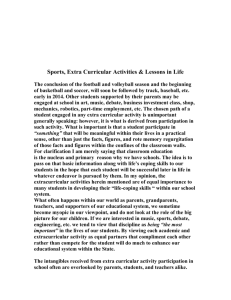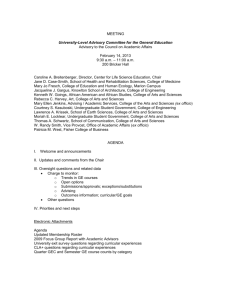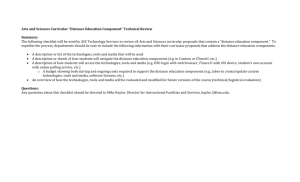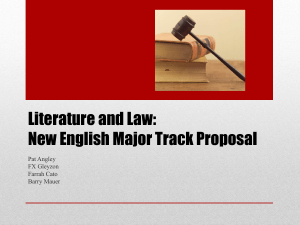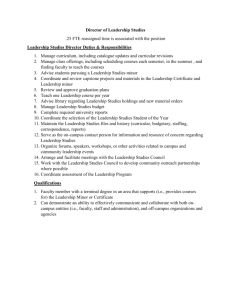Mary_Stuart - Higher Education Academy
advertisement
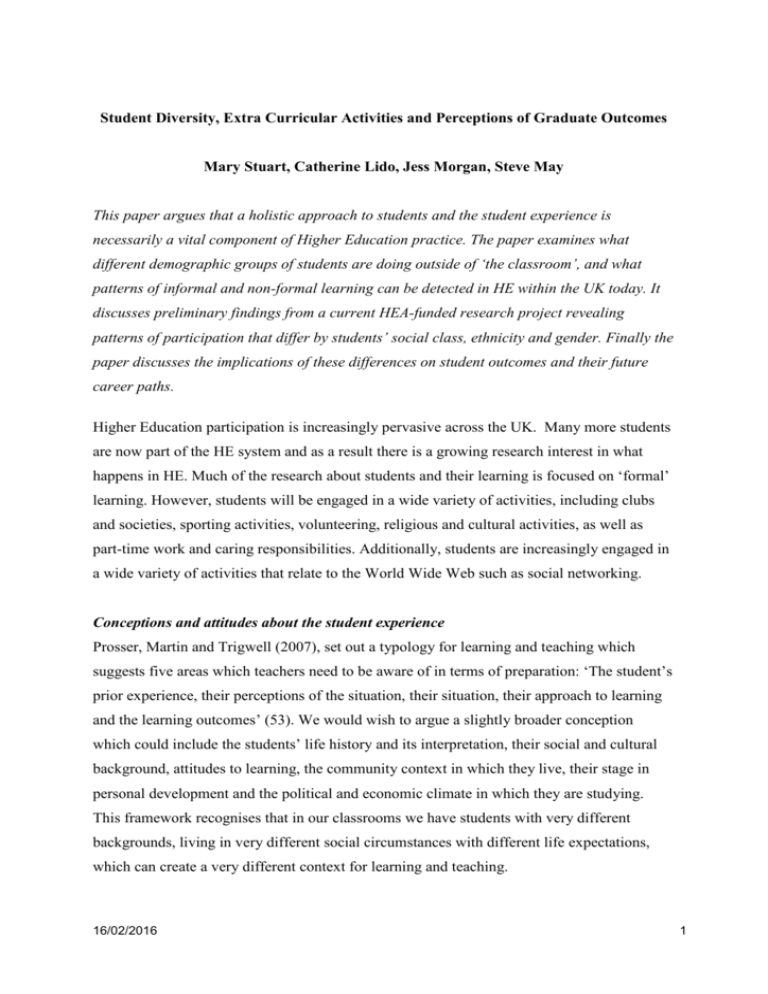
Student Diversity, Extra Curricular Activities and Perceptions of Graduate Outcomes Mary Stuart, Catherine Lido, Jess Morgan, Steve May This paper argues that a holistic approach to students and the student experience is necessarily a vital component of Higher Education practice. The paper examines what different demographic groups of students are doing outside of ‘the classroom’, and what patterns of informal and non-formal learning can be detected in HE within the UK today. It discusses preliminary findings from a current HEA-funded research project revealing patterns of participation that differ by students’ social class, ethnicity and gender. Finally the paper discusses the implications of these differences on student outcomes and their future career paths. Higher Education participation is increasingly pervasive across the UK. Many more students are now part of the HE system and as a result there is a growing research interest in what happens in HE. Much of the research about students and their learning is focused on ‘formal’ learning. However, students will be engaged in a wide variety of activities, including clubs and societies, sporting activities, volunteering, religious and cultural activities, as well as part-time work and caring responsibilities. Additionally, students are increasingly engaged in a wide variety of activities that relate to the World Wide Web such as social networking. Conceptions and attitudes about the student experience Prosser, Martin and Trigwell (2007), set out a typology for learning and teaching which suggests five areas which teachers need to be aware of in terms of preparation: ‘The student’s prior experience, their perceptions of the situation, their situation, their approach to learning and the learning outcomes’ (53). We would wish to argue a slightly broader conception which could include the students’ life history and its interpretation, their social and cultural background, attitudes to learning, the community context in which they live, their stage in personal development and the political and economic climate in which they are studying. This framework recognises that in our classrooms we have students with very different backgrounds, living in very different social circumstances with different life expectations, which can create a very different context for learning and teaching. 16/02/2016 1 In Universities we generally acknowledge the existence of informal and non-formal learning, but we do not necessarily know how engaged our students are in such activities and we may not connect it or relate it to the formal learning environment. One of the key reasons why informal learning is important is that it is often related to the experience of ‘cultural and social capital’ (Bourdieu, 1977). In other words ‘informal’ and ‘non-formal’ learning, like all learning, is not a passive process and is not context-neutral. Students engage in informal or non-formal learning (or not) as a matter of ‘taste’, structured by prior background, cultural experiences and economic circumstances. It is therefore vital to contextualise extra curricular activities in relation to contextualised life histories, rooted in socio-economic, political and cultural experiences. These experiences will impact not only on students’ time at University but beyond into the workplace and in wider society. Several researchers have identified habitus as an issue for ‘non-traditional’ students (Archer et al, 2003; Thomas, 2002; Bowl, 2002), along with issues of social capital (Field & Spence, 2000; Little, 2006; Stuart, 2006), the impact of part-time work, debt and family commitments (Solomon & Woodfield, 2005) and ‘belonging’ (Calbrese & Poe, 1990; Archer et al, 2003). Whilst there are no longer any ‘typical’ graduates (Little, 2006), employers still have a rather blinkered view of what a ‘good graduate’ may be (Pearson, 2006; Barber & Hill, 2005). Extra curricular activities have a significant impact on the transition into work, and certain types of extra curricular activities, including (but not limited to) voluntary work and relevant work experience, give greater access to graduate jobs (Brooks, 2006; Tchibozo, 2007). Context of learning in HE in post/late/high modernity Globalisation and the emergence of neither high or low but ‘just’ culture (Eagleton, 2000) are underpinned by technology. Much has been written about the techno-scientific revolution and its effects on learner identity and behaviour (e.g. Frand, 2000). Technology allows for instantaneous communication and flow of capital. It breaks down boundaries between nations, and as ‘content’ is now in the hands of any individual it further breaks down notions of valid or ‘real’ verses invalid or ‘trivial’ knowledge (Usher, Bryant & Johnston, 1999). This is transforming our identities, what we know and how we live. Technology contributes to an increasing sense of borderlessness, as we have fewer and fewer boundaries that are fixed. Movement of peoples, whether it is the flow of international students, economic migrants or refugees, are evident within our cities and our Universities. 16/02/2016 2 Such phenomena flow from globalisation and create the new ‘risk society’ (Beck, 1992). As nations are less able to control what is happening in their state, risk moves from the state to the individual who becomes as Beck argues ‘responsible for their own biography’. The resultant fragility of identities impacts on our sense of self and, therefore, the context for learning. As we bear more risk, our boundaries blur and security seems less possible, we seek certainties in a world which is constantly uncertain , and we try to focus control on ourselves (Field, 2000). This is further manifest in the growth of extreme sports clubs on University campuses, to push to the extreme to test our bodies and to find our ‘true selves’. Another area of growth is societies that are either religious or culturally based. This perhaps indicates a desire to hold onto, or even recreate, our own cultural heritages. This can be seen as a form of resistance to the dominant culture and arguably it is also an attempt to develop resilience for fragile identities in an uncertain world. Social Identity Theory (Tajfel & Turner, 1979), reinforces this notion that ‘identity-threat’ drives the need to reinforce self-esteem, via strong and positive ‘in-group identification’. Therefore, developing a strong and positive affiliation with one’s university and fellow peers is key for producing a positive sense-of-self and increased self-esteem. This need for positive identification may be particularly important for marginalised, stigmatised and minority groups (Brown, 2000). Thus, the social context for learning is overlaid with different groups’ process of identification, access to power and access to those taken-for-granted elements of society that define where different identities are located within the broader social structure. Each biography will affect students’ engagement with knowledge, and will shape how learning is understood and perceived. In other words, the context for learning today is shaped by power, socio-economic and cultural position with differing effects for diverse student groups. Recognising these effects suggests the importance of teachers understanding the wider context of their students’ lives. Field (2000) suggests a typology of learners; the permanent learner, the traditional learner, the instrumental learner and the non-learner, and we would argue that these ‘types’ will relate to different groups’ life experiences within their social and cultural positioning. This creates a particular environment in which our students come to us, not as empty vessels to be filled but as real people with different experiences, identities and belonging/ self-esteem 16/02/2016 3 needs and understandings in a fast changing and fragile world. It is with this context and set of theoretical perspectives that we undertook the research on ‘extra curricular’ activities. The Project The research was based on a successful bid to the HEA and examines the effects of ‘extra curricular activities’ on students’ employment prospects. It is premised on the belief that there is no one student experience in a massified system (Scott, 1995) and that it is the differences between demographically diverse students and their ‘chosen’ lifestyles that could potentially reveal differences in the impact of extra curricular activities on graduate outcomes. While there is little research that examines student differences and extra curricular activities in higher education in the UK, there is some literature on the topic from the USA, particularly at the high school level. Significant differences in students’ engagement with extra curricular activities have been found across gender (Dumais, 2002; Kaufman & Gabler, 2004) and ethnic groups (Farkas, 1996; Flores-Gonzalez, 2000). Whilst ideas of ‘taste’ have been found to affect which extra curricular activities are considered valuable assets and which are not (Bryson, 1996), engagement with activities in situations where participation is unusual or unexpected has been linked to students’ success in their studies (Lamont, Kaufman & Moody, 2000). The project examined differences highlighted in the literature by considering the impact of extra curricular activities on outcomes such as academic achievement, student satisfaction and progression for UK HE students, and the value placed on extra curricular activities by students, employers and alumni. Preliminary findings The initial stage of the project involved a large scale survey of approximately 1000 students from 4 UK HE institutions. These institutions were chosen because they are diverse in terms of geography, type of institution and differing student populations, therefore offering outcomes which have wide applicability. Institution A is a large city based post ’92 institution with mostly young students, half of whom are white and half minority ethnic students, largely doing vocationally focused programmes. Institution B on the other hand has predominantly young white students largely doing academically focused courses. Institution 16/02/2016 4 C has a much higher proportion of mature students and a large proportion of Black and Asian students. Institution D is a small medical school, with a mix of white and Asian students with strong professional family backgrounds. The preliminary demographic information from these institutions is presented below. Demographics by institution Institution A B C D count % count % count % count % ≤ 21 years old 210 62 187 81 42 29 28 65 mature students 129 38 44 19 104 71 15 35 Vocational 259 75 61 26 63 43 43 100 Academic 85 25 170 74 85 57 0 0 White 148 43 190 83 54 37 18 42 Black 62 18 2 1 53 36 4 9 Asian 94 27 18 8 16 11 19 44 Other 39 12 18 8 24 16 2 5 Unemployed 1 1 2 1 1 1 1 2 Unskilled Trade 7 2 6 3 12 9 1 2 Skilled Trade 58 19 35 16 26 19 10 24 Modern Prof. 46 15 45 21 14 10 6 15 Professional 158 51 96 45 65 47 20 49 Family HE experience 238 70 165 71 100 68 33 77 4 1 10 4 6 4 2 5 Not religious 103 31 140 61 32 22 18 42 Christian 109 32 49 21 87 59 7 16 Muslim 61 18 1 1 14 10 10 23 Hindu 29 9 3 1 2 2 6 14 Courses Ethnicity Social Class* Fees Bursary Religion *social class correlates significantly with having a bursary (r=.12) and prior family experience of HE (r=.25) Examination of the basic frequencies revealed that at Institution A , attending bars and the students’ union is less important to the majority of the students than attending the library and social networking. Many more are religious than not. At institution B, seeing friends, shopping and visiting pubs/bars is more important to them than visiting the library and very few are religious. At institution C, students spend more time in the library and with family 16/02/2016 5 than on other university activities, indicating that their time on campus is strategic. At institution D, there is a strong commitment to the students’ union and sports activities, and a strong preference for using bars and pubs. Analysis of Variance revealed that the activities students are engaged in, and the amount of time they spend engaged in these activities, varies depending on their ethnicity, age and gender. A pattern of informal learning is emerging from the data, whereby White students are focused more on seeing friends (p<.01), socialising in bars (p<.01) and cafes (p<.05) compared to minority ethnic students, who are focused more on the library (p<.01), religious activities (p<.01) and family commitments (p<.01). Mature students spend more time in the library than younger students (p<.01), and male students spend more time in pubs and bars (p<.01) and doing sports (p<.01) than females. Compared to middle class students, working class students are less likely to be engaged in clubs/societies (p<.01), councils/committees (p<.07) , volunteering (.07) or other hobbies (p<.01). These students also spend more time in paid employment (p<.01) and less time studying (p<.05). Students from lower socioeconomic groups identify less with university clubs and societies (p<.05), and are more likely to say that their commitments and activities negatively impact on their university performance (p<.05). Given the perceived belief that engagement in such activities has a positive impact on employment prospects, the results may suggest that these students’ lack of cultural capital is being re-enforced during their time at University and the class divide will continue into their future lives. Conclusions Further work, including focus groups with students to gain a greater insight into their reasons for the choices they made in participation is underway. The project will also interview alumni and employers to test the perceived benefits of extra curricular activities: this data will inform the final project report. However at this stage and based on the survey data, class, ethnicity and gender contribute to key differences in the type of learners we see in our universities, both in formal and informal contexts. The typology produced by Field (2000) of the permanent learner, the traditional learner, the instrumental learner, and the non-learner is relevant to this study. Emerging patterns of correlations reveal a sub-category of students who we have called ‘Joiners’, those heavily engaged in activities offered by their University and students’ union, and a reasonable amount of paid employment (but not too much); in Field’s terms the permanent and in many cases traditional learners, who do better in their 16/02/2016 6 studies. Alternatively, a different sub-category who we call ‘Doers’ spend more time on paid employment, family commitments, religious involvement and studying, but feel less connection to the university and students’ union. The data suggests that different groups of students engage differently, and some students not at all, which suggests that their outcomes in terms of marks and future employment outcomes may also be different. In an increasingly personally risky and fragile world this suggests (again) that those who understand the rules of the HE game will benefit socially, personally and practically. In higher education we acknowledge the existence of the ‘extra curricular’, but we do not find ways to integrate it into our classrooms. However, the present findings suggest an urgent need for a more holistic approach to pedagogy in higher education. ‘Non-joiners’ in our study often experience barriers to participation in union clubs/societies such as financial worry, paid employment, childcare commitments, geographical location and family/community expectations (e.g. for many, the library or a student committee may be a more acceptable social space than the pub). We need to place ‘our students’ and ‘their experiences’ within the context of their social lives, backgrounds and ‘biographies’, to assist them to make the best of their time with us both in and beyond the classroom. Universities and employers need to be more inclusive about the activities students are engaged in, in order to create a more comprehensive learning environment, more rounded job candidates and to prevent future students feeling ‘unknown’. Finally, since the ultimate social purpose of any University is to create more rounded and active citizens, we need to use their engagements and activities to help them reflect on their social existence in order to achieve this end. 16/02/2016 7 References Archer, L., Hutchings, M. & Ross, A. (2003). Higher education and social class: issues of exclusion and inclusion. London: Routeledge Falmer. Barber, L. & Hill, D. (2005). Is graduate recruitment meeting business needs? Brighton: IES and CIHE. Beck, U. (1992). Risk society: towards a new modernity. London: Sage. Bowl. M. (2002). Non traditional entrants to higher education. Stoke: Trentham Books. Bourdieu, P. (1977). Outline of a theory. Cambridge: University Press. Brooks, R. (2006). Learning and work in the lives of young adults. International Journal of Lifelong Learning 25 (3), 271-289. Brown, R. (2000). Group processes. Oxford: Blackwell Pub. Bryson, B. (1996). Anything but heavy metal: symbolic exclusion and musical dislikes. American Sociological Review 61 (5), 884-899. Coare, P., & Johnston, R. (2003) (Eds). Adult learning, citizenship and community voices: Exploring community-based practice. Leicester, UK: National Institute of Adult Continuing Education. Dumais, S. (2002). Cultural capital, gender, and school success: The role of habitus. Sociology of Education 75 (1), 44-68. Eagleton, T. (2000). The idea of culture. Oxford: Blackwell Pub. Farkas, G. (1996). Human capital or cultural capital? Ethnicity and poverty groups in an urban district school. New York: deGruyter. Field, J. (2000). Lifelong learning and the new educational order. Stoke-on-Trent: Trentham Books. Field, J. & Spence, L. (2000). Informal learning and social capital. In F. Coffield (Ed.) The necessity of informal learning. Bristol: The Policy Press. Flores-Gonzalez, N. (2000). The structuring of extra curricular opportunities and Latino student retention. Journal of Poverty 4 (1), 85-108. Frand, J. L. (2000). The information-age mindset: Changes in students and implications for higher education. Educause Review 35 (5), 15-24. Kaufman, J. & Gabler, J. (2004). Cultural capital and the extra curricular activities of girls and boys in the college attainment process. Poetics 32, (2), 145-168. Lamont. M., Kaufman, H, & Moody, M. (2000). The best of the brightest: definitions of the ideal self among prize-winning students. Sociological Forum 15 (2), 187-224. 16/02/2016 8 Little, B. (2006). The student experience and the impact of social capital. In I. McNay (Ed.) Beyond mass higher education. Maidenhead: SRHE, Open University Press. Pearson. R. (2006). The demise of the graduate labour market. In I. McNay (Ed.) Beyond mass higher education. Maidenhead: SRHE, Open University Press. Prosser, M., Martin, E. & Trigwell, K. (2007). Academics’ experience of research, teaching and subject-matter understanding: A phenomenographic analysis of their interrelations. In N. Entwistle and P. Tomlinson (Eds) Student learning and university teaching. Leicester: The British Psychological Society. Scott. P. (1995). The meaning of mass higher education. Buckingham: SRHE Open University Press. Solomon, L. & Woodfield, R. (2005). Minority group students’ experience of HE: Sussex as a case study. University of Sussex internal report. Stuart. M. (2006). ‘My Friends made all the difference’. Getting into and succeeding at University for first-time entrants. Journal of Access Policy and Practice (Summer, 2006), 27-40. Tajfel, H, & Turner, H.C. (1979). An integrative theory of inter-group conflict. In W.G. Austin & S. Worchel (Eds) The social psychology of intergroup relations. Monterey, Calif.: Brooks/Cole Pub. Co. Tchibozo, G. (2007). Extra curricular activity and the transition from higher education to work: A survey of graduates in the United Kingdom. Higher Education Quarterly 61 (1), 37-56. Thomas, L. (2002). Student retention in higher education: The role of institutional habitus. Journal of Education Policy, 174-190. Usher, R., Bryant, I. & Johnston, R. (1997). Adult education and the postmodern challenge: Learning beyond the limits. London: Routledge. 16/02/2016 9
